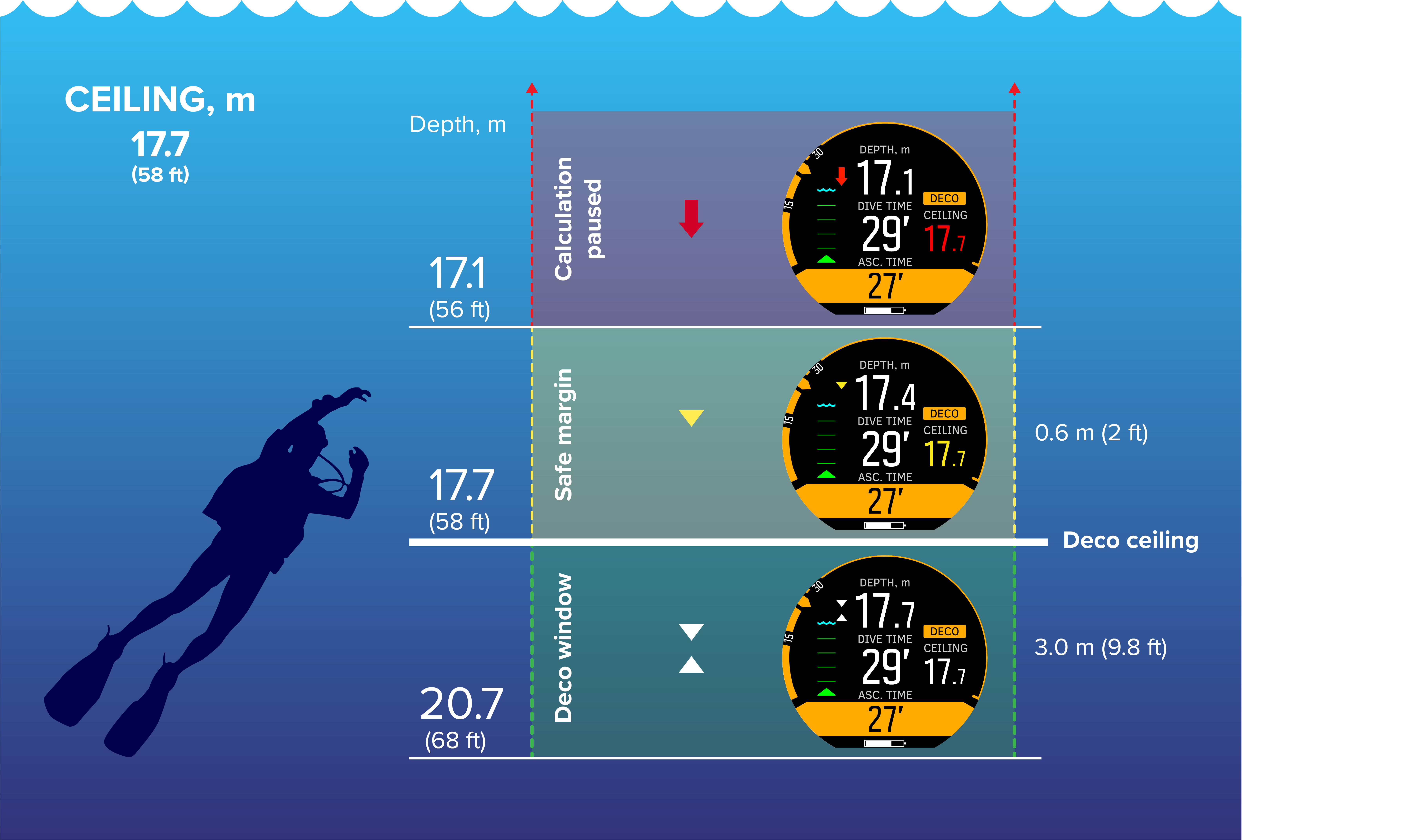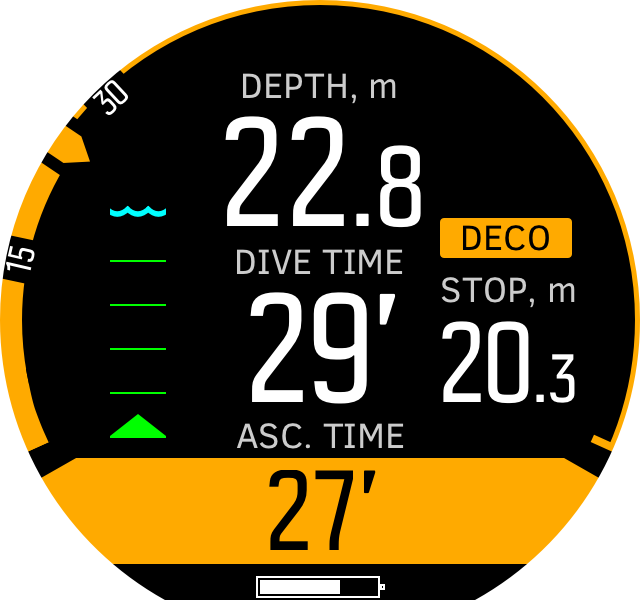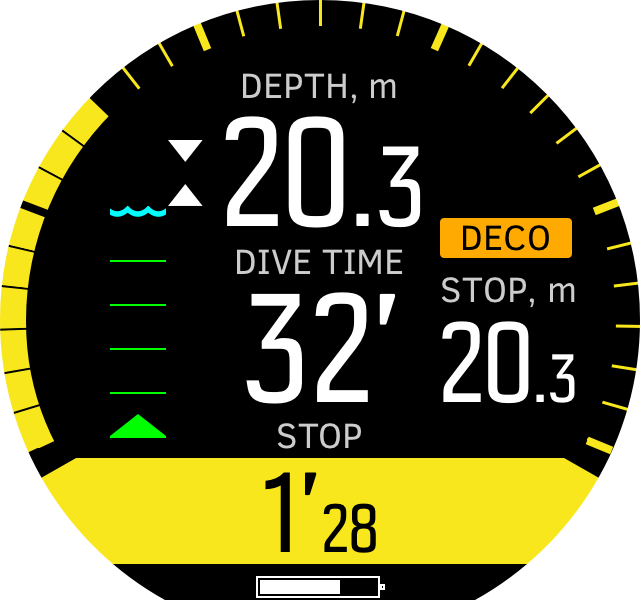Suunto D5 User Guide
Decompression dives
If you exceed the no decompression limit on a dive, when no deco time reaches zero, your dive changes into a decompression dive. Therefore, you must perform one or more decompression stops on your way to the surface.
Ascent information is always presented with two values:
- ceiling: depth that you should not go above
- asc. time: optimum ascent time in minutes to surface with given gases
NEVER ASCEND ABOVE THE CEILING! You must not ascend above the ceiling during your decompression. In order to avoid doing so by accident, you should stay somewhat below the ceiling.
On a decompression dive, there can be three kinds of stops:
- Safety stop: this is a recommended three-minute stop for every dive over 10 meters (33 ft).
- Deepstop: this is a recommended stop when you dive deeper than 20 m (66 ft).
- Decompression stop: this is a compulsory stop on your decompression dive that is for your safety, preventing decompressions sickness.
In Dive settings » Parameters, you can
- turn deepstop on or off (it is on by default)
- adjust the safety stop time to be 3, 4 or 5 minutes (default is 3 minutes)
- set last stop depth to 3.0 m or 6.0 m (default is 3.0 m)
The following illustration shows a decompression dive where the ceiling is at 17.7 m (58 ft):

From bottom to top you see the following in the above image:
There is a decompression window (Deco window) that is the distance between the decompression ceiling (Deco ceiling) plus 3.0 m (9.8 ft) and the decompression ceiling. So the deco window in this example is between 20.7 m (68 ft) and 17.7 m (58 ft). This is the area where decompression takes place. The closer to the ceiling you stay, the more optimal the decompression time is.
When you ascend close to the ceiling depth and enter the deco window area, two arrows appear in front of the depth value. The downward and upward pointing white arrows indicate that you are within the deco window.
If you ascend above the ceiling depth, there is still a safe margin area, equaling to ceiling depth minus 0.6 meters (2 ft). So in this example, it is between 17.7 m (58 ft) and 17.1 m (56 ft). In this safe margin area, decompression calculation still continues, but you are advised to go down below the ceiling depth. This is indicated by the ceiling depth value turning yellow with a downward pointing yellow arrow in front of the depth value.
If you go above the safe margin area, the decompression calculation is paused until you go back down below this limit. An audible alarm and a downward pointing red arrow in front of the depth value indicate unsafe decompression.
If you ignore the alarm and stay above the safe margin for three minutes, Suunto D5 locks the algorithm calculation, and decompression information will not be available anymore on the dive. See Algorithm lock.
Decompression display examples
Suunto D5 shows the ceiling value always from the deepest of these stops.
Below is a typical decompression dive view showing ascent time and the first recommended deepstop at 20.3 meters:

Below is an example of what Suunto D5 displays during an optional deepstop:

Below is an example of what Suunto D5 displays during a compulsory stop:

If the ceiling is broken for more than 3 minutes, the decompression algorithm gets locked.
With decompression stops, the ceiling is always decreasing while you are near the ceiling depth, providing continuous decompression with optimum ascent time.
It is always recommended to keep close to the decompression ceiling when ascending.
Ascent time is always the minimum time needed to reach the surface. It includes:
- Time required for deepstops
- Ascent time from depth at 10 m (33 ft) per minute
- Time needed for decompression
When diving with multiple gases, remember that the ascent time is always calculated with the assumption that you use all the gases found in the Gases menu. Always check that you have only the gases for your current planned dive defined before you dive. Remove the gases that are not available for the dive.
YOUR ACTUAL ASCENT TIME MAY BE LONGER THAN DISPLAYED BY THE DIVE COMPUTER! The ascent time will increase if you: (1) remain at depth, (2) ascend slower than 10 m/min (33 ft/min), (3) make your decompression stop deeper than at the ceiling, and/or (4) forget to change the used gas mixture. These factors might also increase the amount of breathing gas required to reach the surface.
Last stop depth
You can adjust the last stop depth for decompression dives under Dive settings » Parameters » Last stop depth. There are two options: 3 m and 6 m (9.8 ft and 19.6 ft).
By default, the last stop depth is 3 m (9.8 ft). This is the recommended last stop depth.
This setting does not affect the ceiling depth on a decompression dive. The last ceiling depth is always 3 m (9.8 ft).
Consider setting the last stop depth to 6 m (19.6 ft) when you dive in rough sea conditions and stopping at 3 m (9.8 ft) is challenging.